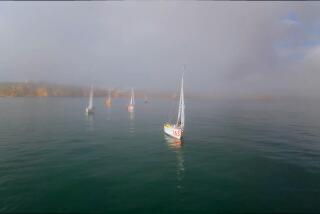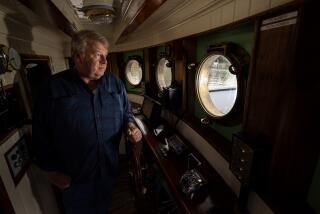Voyage of the Pilgrim : Tall Ship Heads to Sea for Annual Coastal Cruise
- Share via
ABOARD THE PILGRIM — The word among the crew on the tall ship Pilgrim was that bosun Tom Burkholder was a nice guy. Serene. Calm. Dedicated.
But don’t get too friendly, they warned. Burkholder can make you wash the decks, tar the ratlines or ropes, or worse. His specialty, and one which he repeated with gusto last week, is his thunderous 5:50 a.m. wake up call: “GOOD MORNING, PILGRIM!! Everybody UP!”
It’s enough to raise the dead, said Alan Sorkin, a volunteer sailor from Dana Point, who joined other tired deckhands who stayed in their bunks, hoping to catch that last bit of shut eye as Burkholder wandered back on deck. Two minutes later, he was back. “I DON’T SEE ANYBODY M-O-O-VING!”
“What did I tell you?” said Sorkin, 43. “After you hear him in the morning, you really don’t wanna be his friend.”
For much of the year, the 130-foot Pilgrim is moored at Dana Point Harbor, near the Orange County Marine Institute, which owns the vessel and coordinates “living history” programs for thousands of schoolchildren and weekend visitors each year. It is the biggest revenue maker for the institute, accounting for more than $500,000 of the facility’s $2 million in annual revenue.
But in late summer, the Pilgrim takes to sea as it did last week for an annual maintenance run to San Diego, then up the coast to the Santa Barbara islands, and back in time for the annual Tallships Festival at Dana Point Harbor. This year the festival will take place Sept. 7-8.
Aboard are volunteers, a crew of more than 30 men and women whose love of sailing on the Pilgrim takes top priority. For those on board, the three-week trip is a chance to develop lasting friendships, while enjoying a glimpse of how seafaring sailors lived and worked in the 1830s.
“I love it,” said Douglas Corey, 49, of San Pedro. “I sometimes think I was born 100 years too late.”
Included in the recent trip was Burkholder, 27, a lanky bioengineering graduate student from UC San Diego, several teachers, a retired NBC cameraman, and some executives such as Corey, who is a market analyst for a Torrance aerospace firm.
Corey was on the first crew to sail the Pilgrim in 1980. He is now the ship’s sailing master, and it is he who barks out commands to Burkholder and mast captains such as Chris Pecharka, 33, an artist and instructor at the institute.
“You know,” Pecharka said, “I had car problems and a lot of other stuff nagging me before I left on this trip. But I haven’t thought of them at all. . . . It’s fun to be someone else for two weeks.”
Fun and hard work. Volunteers, who ranged in age from 16 to 75, take written tests and hours of training before they earn a deckhand rating and are permitted to sail on the Pilgrim. Competition for the annual trip is keen, with many volunteers averaging 90 or more hours spent cleaning, scrubbing and painting the ship during the year.
Although there’s not a lot of gleam or brass aboard the vessel, it’s a working boat, and when it sails, “it runs on the muscle and sweat” of its crew, Corey said.
*
Much of the hard work involves the fact that the vessel is a replica of the original Pilgrim, which was built in 1825. The original ship, immortalized by Richard Henry Dana Jr., in the American seafaring novel, “Two Years Before the Mast,” had no engine and was a square-rigged ship carrying cattle hides from California. The original Pilgrim was destroyed in a fire at sea in 1856.
The replica was built as a Baltic trader in 1945, but was converted into a brig in the 1970s. The ship has 14 sails, 140 types of lines--each with nautical names that sailors must learn--and miles of rigging.
Simple things, such as hoisting anchor, can be a test in stamina and grit for the Pilgrim’s crew, which uses a windlass, a simple winch operated by a crank at both ends, to haul up the 800-pound anchor.
“This is the part you don’t like,” said William Mills, 31, of San Diego, as he and other crew mates prepared to weigh anchor from Avalon Harbor off Catalina Island.
About 70 minutes later, with sweat pouring off the crew’s faces, the anchor was finally up. The engine throbbed steadily as the Pilgrim finally eased out of Avalon and set course for Santa Barbara Island, about 44 miles away.
But the job added a casualty to the Pilgrim’s injury list.
Among them was Alex Siman, 75, a retired aerospace engineer from Dana Point, who had been nursing a groin injury, when he felt something tear in his lower abdomen. For him, it meant that instead of sailing another week, he would be replaced.
Those already nursing injuries included one person who slipped and fell so hard he lost consciousness and a woman with a badly sprained knee, said skipper Daniel T. Stetson. Stetson did a two-day stint as skipper for Jim Wehan, the Pilgrim’s regular captain who went to the mainland, where he is a part-time math teacher.
*
Sore muscles and injuries aside, both male and female crew members said they accepted the fact there may be hardships aboard.
“I don’t mind it,” said Christie Rutter, 28, of Dana Point, who is in charge of the Pilgrim’s educational programs. “You sign up for it, so you come to expect hard work. And, like I always tell the kids who come aboard, ‘If you don’t take care of the ship, it won’t take care of you.’ ”
What makes up for the hardships, crew members said, is the sailing.
Setting the sails is a fascinating operation, with the hardiest men and women going high above the deck on ratlines, and unfastening the gaskets (rope) and readying the Pilgrim’s sails.
For many who scamper aloft, it’s a dicey balancing act, especially when working on the royal yard, the ship’s highest sail.
“It’s 84 feet up, and believe me, it’s all of that,” said Roland Johnson, 49, a consultant for a paper products company who lives in La Verne. “It’s a real E-ticket ride up there. But Disneyland doesn’t have anything like that.”
Even though he’s clipped in with a safety line, Johnson said it’s tough because the boat is pitching with each ocean swell and every movement “seems magnified” from above.
But there is a sense of accomplishment when the Pilgrim is fully under sail.
“It’s the best time to be aboard the ship,” Sorkin said. “We get each sail out and it takes a while, but by the time we’re done and she catches that first breath of wind and starts to move, it’s indescribable.”
More to Read
Sign up for The Wild
We’ll help you find the best places to hike, bike and run, as well as the perfect silent spots for meditation and yoga.
You may occasionally receive promotional content from the Los Angeles Times.






